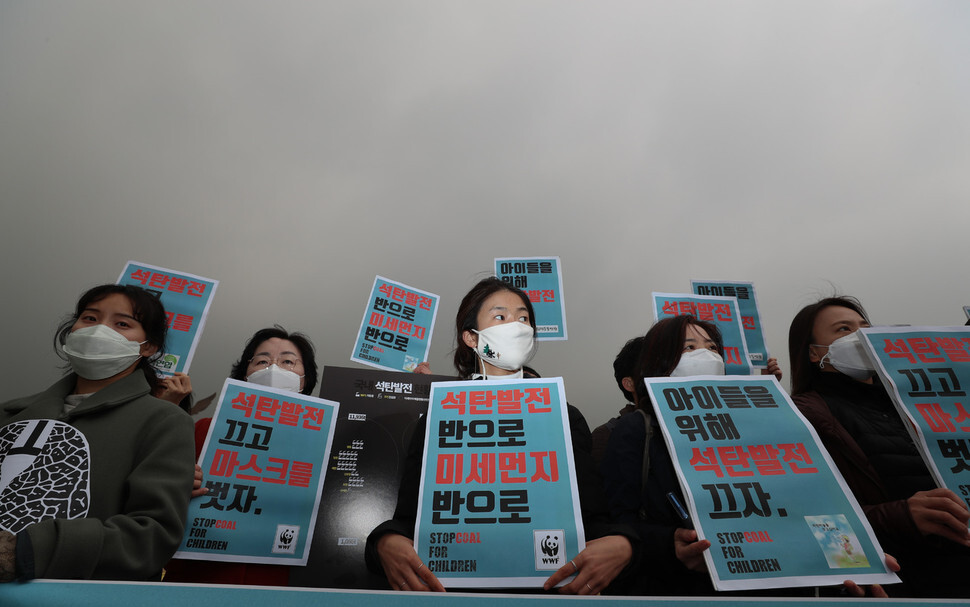hankyoreh
Links to other country sites 다른 나라 사이트 링크
S. Korea reduces coal pollution by half compared to previous year

The amount of fine particle pollution emitted from coal-fired power plants is down by roughly half from 2018 levels amid coal reduction measures implemented this December to cut back on the increase in fine particle emissions during winter.
The Ministry of Trade, Industry and Energy (MOTIE) announced on Dec. 11 that after beginning its coal-fired power reduction measures at midnight on Dec. 1 by halting operations of 12 generators and imposing a maximum of 45 generators (80% of generation output) for a period of one week, fine particle emissions were down by around 45.8% (187 tons) from the same period in 2018 -- an equivalent effect to suspending the operation of 16 to 21 generators a day. The electricity reserve rate was preserved at the “stable” level of 13.1-17.3% over the same period, MOTIE explained.
At a governance issue review and coordination meeting on Nov. 28, the South Korean government finalized winter electricity supply and coal-fired power reduction measures, announcing that it would “pursue the maximum possible reduction of coal-based power while maintaining stable electricity supplies.” To achieve this, it made plans for a first-ever ongoing winter suspension of operations of 8 to 15 coal-fired generators.
MOTIE is also working with civic groups on a campaign to reduce energy consumption in 20 regions throughout the country to beef up its management of energy demands during the winter. Together with local governments, it plans to conduct two-week focused reviews each month with appropriate heating temperatures for public institutions (maximum of 18 degrees) and high-consumption private structures (20 degrees). MOTIE also plans to crack down on businesses that operate heating with their doors or windows open in 18 major commercial zones during the anticipated peak period of power consumption, the fourth week of January in 2020.
By Kim Eun-hyung, staff reporter
Please direct comments or questions to [english@hani.co.kr]

Editorial・opinion
![[Column] The state is back — but is it in business? [Column] The state is back — but is it in business?](https://flexible.img.hani.co.kr/flexible/normal/500/300/imgdb/original/2024/0506/8217149564092725.jpg) [Column] The state is back — but is it in business?
[Column] The state is back — but is it in business?![[Column] Life on our Trisolaris [Column] Life on our Trisolaris](https://flexible.img.hani.co.kr/flexible/normal/500/300/imgdb/original/2024/0505/4817148682278544.jpg) [Column] Life on our Trisolaris
[Column] Life on our Trisolaris- [Editorial] Penalties for airing allegations against Korea’s first lady endanger free press
- [Editorial] Yoon must halt procurement of SM-3 interceptor missiles
- [Guest essay] Maybe Korea’s rapid population decline is an opportunity, not a crisis
- [Column] Can Yoon steer diplomacy with Russia, China back on track?
- [Column] Season 2 of special prosecutor probe may be coming to Korea soon
- [Column] Park Geun-hye déjà vu in Yoon Suk-yeol
- [Editorial] New weight of N. Korea’s nuclear threats makes dialogue all the more urgent
- [Guest essay] The real reason Korea’s new right wants to dub Rhee a founding father
Most viewed articles
- 1Amid US-China clash, Korea must remember its failures in the 19th century, advises scholar
- 2[Column] The state is back — but is it in business?
- 360% of young Koreans see no need to have kids after marriage
- 4New sex-ed guidelines forbid teaching about homosexuality
- 5Trump’s talk of flouting NATO promises sparks apprehension in Seoul
- 6[Column] Why Korea’s hard right is fated to lose
- 7[Guest essay] Maybe Korea’s rapid population decline is an opportunity, not a crisis
- 8[Reporter’s notebook] In Min’s world, she’s the artist — and NewJeans is her art
- 9Presidential office warns of veto in response to opposition passing special counsel probe act
- 10[Column] Life on our Trisolaris